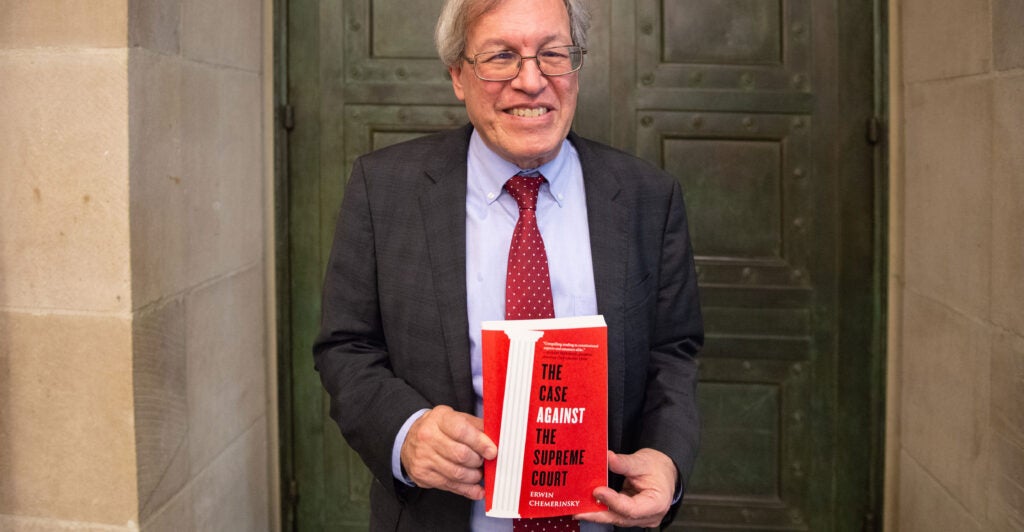In Students for Fair Admissions v. Harvard, the Supreme Court last June banned schools from discriminating on the basis of race in admissions. In response to that decision, many left-wing administrators launched what in an earlier era was called “massive resistance.”
For example, University of California-Berkeley Law School Dean Erwin Chemerinsky and University of Michigan Vice President and General Counsel Timothy Lynch hosted a legal conference that coached universities on how to circumvent the decision.
Just a few days earlier, Chemerinsky was caught on camera explaining how he avoids California’s ban on racial preferences in faculty hiring: “If ever I’m deposed, I’m going to deny I said this to you.”
Berkeley and Michigan are just two of many schools scrambling to preserve their race-based discrimination post-Students for Fair Admissions.
Stanford Law School may be the latest culprit.
Before the Harvard case, Stanford Law justified its race-based admissions policies as delivering a “diverse student body,” as if a candidate’s outward appearance determines inward character.
In non-admissions programs, however, the law has always forbade Stanford from discriminating. The Civil Rights Act and California’s civil rights laws have always forbidden racial discrimination. The “diversity rationale,” which the Supreme Court erased in the Harvard case, was an exception that applied only to admissions.
Even so, the Harvard case reminded schools that they cannot racially discriminate in any context.
Unfortunately, Stanford may have ignored that reminder in at least one of its academic programs, the Stanford Law Scholars Institute.
In 2022, Stanford launched the institute to “address obstacles that underrepresented minority, first-generation, and low-income undergraduate students in particular might face to accessing legal education at Stanford law school.”
On its diversity, equity, and inclusion page, Stanford publicly announced that the institute was a “pipeline project for diversity in admissions.”
After the Harvard case, Stanford replaced the program’s mission statement with a race-neutral description, which might signify that Stanford had turned over a new leaf and ended its discriminatory practices.
But the evidence suggests, instead, that Stanford is simply hiding them.
For one thing, the DEI website still describes the institute as a pipeline for diversity in admissions. For another, Diane Chin, who runs the institute, recently declared that it remains for “communities underrepresented in the legal profession.”
In fairness, “underrepresented” could mean many things, both racial and nonracial. And when asked how race and ethnicity are used in the selection process, Chin responded, “race and ethnicity information is not included as part of the application process.”
But that isn’t true.
The institute’s application fishes for demographic information at multiple stages. It asks for country of origin, immigration status, family immigration history, and the language spoken in the home as a child—all questions which can reveal race and ethnicity.
The program also requires an in-person interview for finalists, where the applicant’s race may be readily identifiable.
After one of the authors (GianCarlo Canaparo) confronted Chin with that evidence, he asked her if she would commit to being transparent about how she uses the data she collects.
She did not respond.
Canaparo followed up, but again, Chin remained silent.
How can we be sure the institute isn’t giving racial preferences if its director won’t tell the truth about the data she collects and won’t commit to being transparent about how she uses it?
Chin’s public support for “racial equity”—which is often an excuse for racial discrimination—is further reason to suspect that she has not given up on racial preferences.
What’s more, one of the co-leaders of the institute was Tirien Steinbach, the infamous DEI dean of Stanford Law who resigned in disgrace after she harangued U.S. Circuit Court of Appeals Judge Kyle Duncan and supported a screaming mob that silenced him when he tried to give a speech on campus.
Since Steinbach’s resignation, Chin now co-leads the institute with Faye Deal. Both Chin and Deal are committed to the often-discriminatory ideology of DEI.
Deal serves as the associate dean for admissions and financial aid at Stanford Law, which means she has at least some power to make sure that the institute is, in fact, a pipeline to admission. She also previously served as a Cabinet member in Stanford Law’s DEI initiative.
Chin used to serve as the executive director of an organization that advocates for racial preferences in government programs and policies. She also founded the Stanford Center for Racial Justice, which is committed to “Antiracism,” an ideology that explicitly endorses racial discrimination to eliminate disparities.
The administrators’ DEI-laden record suggests that the Stanford Law Scholars Institute remains, as it originally was, a tool to racially discriminate in a misbegotten quest for diversity.
To ensure that it isn’t, civil rights organizations, such as Students for Fair Admissions, and state and federal civil rights enforcers should investigate the institute to ensure that it no longer discriminates based on race.
The idea that race is diversity, or that race is a good proxy for diversity, is still gospel to some on the political Left despite the Supreme Court’s ban and overwhelming evidence to the contrary.
They remain committed to racial balancing even if they now hide it. So, civil rights lawyers and plaintiffs should continue to keep schools—and administrators like Chin and Deal—under a close microscope.
And if, perhaps, Chin and Deal have reformed their ways, they should commit to transparency so that the specter of racial discrimination, which haunts them, can finally be dispelled.
Have an opinion about this article? To sound off, please email letters@DailySignal.com and we’ll consider publishing your edited remarks in our regular “We Hear You” feature. Remember to include the URL or headline of the article plus your name and town and/or state.
